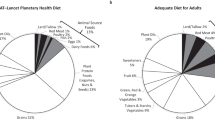Abstract
IN ruminant animals fed exclusively on roughages there is a close positive association between voluntary food intake and the digestibility of the diet. It has been suggested that this association occurs because foods of high digestibility are cleared from the digestive tract—by absorption and the expulsion of undigested residues—at a faster rate than are foods of low digestibility1. Foods which differ from one another in digestibility also differ in such other respects as chemical composition and physical structure, and the association between intake and digestibility (or rate of digestion) may not be entirely a causative one. In particular, differences in chemical and physical composition may affect the taste and texture of the food and thus its palatability. A ruminant may therefore eat more dried grass than straw, for example, not just because the former is more digestible but because it is also more palatable.
This is a preview of subscription content, access via your institution
Access options
Subscribe to this journal
Receive 51 print issues and online access
$199.00 per year
only $3.90 per issue
Buy this article
- Purchase on SpringerLink
- Instant access to full article PDF
Prices may be subject to local taxes which are calculated during checkout
Similar content being viewed by others
References
Blaxter, K. L., Wainman, F. W., and Wilson, R. S., Anim. Prod., 3, 51 (1961).
Bailey, C. B., and Balch, C. C., Brit. J. Nutrit., 15, 183 (1961).
Author information
Authors and Affiliations
Rights and permissions
About this article
Cite this article
GREENHALGH, J., REID, G. Separating the Effects of Digestibility and Palatability on Food Intake in Ruminant Animals. Nature 214, 744 (1967). https://doi.org/10.1038/214744a0
Issue date:
DOI: https://doi.org/10.1038/214744a0
This article is cited by
-
Comportement alimentaire du mouton effets de la nialamide et de la 6-hydroxydopamine
Psychopharmacologia (1974)


